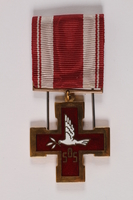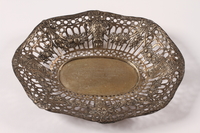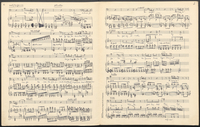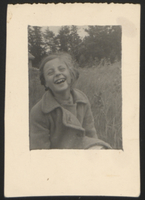Overview
- Brief Narrative
- Silver wall plate preserved by Rosian Zerner. It is inscribed to her maternal grandmother Anna Blumenthal Chason by the Ostjudischen Vereins [Eastern Jewish Association] of Free State Danzig (now Gdansk, Poland) in January 1930. Anna, her husband Julius, and three of their four children immigrated to Palestine on October 24, 1935. This was the day after the birth of Anna's first granddaughter Rosian, to her daughter Gerta Bagriansky in Kovno (Kaunas), Lithuania. After Germany's defeat in World War I (1914-1918), Danzig, previously part of West Prussia, was designated a Free City. It was the major transit port for East European Jews seeking to immigrate and organizations formed to assist the large influx of newcomers. By spring 1939, when Hitler demanded the annexation of Danzig, nearly all of Danzig's Jewish population had departed. In June 1941, Germany invaded Kovno, and Rosian and her parents, Gerta and Paulius, were interned in the Jewish ghetto. There were periodic massacres of Jews in the ghetto, and within six months, half the Jewish population had been murdered by the Germans and their Lithuanian collaborators. On January 16, 1942, her parents pushed Rosian under the fence where she was met by Bronia Budrekaite. She later took Rosian to the home of Natalija Fugaleviciute and Natalija Jegorova. Gerta and Paulius escaped soon after Rosian to the Vilnius ghetto. Her father joined the partisans. Gerta was taken to Natalija's by Rifka Shmukler, another ghetto escapee. After a brief reunion, Gerta and Rosian went into hiding separately. Rosian later was taken to Natalija's sister, Lidija Goluboviene, in Kulautuva, where she stayed until the end of the war, along with over a dozen other children rescued by Lidija. The region was liberated by the Soviet Army in August 1944. Rosian and Gerta rejoined Paulius in Kovno.
- Date
-
commemoration:
1930 January 04
- Geography
-
manufacture:
Germany
received: Danzig (Germany)
- Credit Line
- United States Holocaust Memorial Museum Collection, Gift of Rosian Bagriansky Zerner
- Markings
- front, bottom left corner, hallmark, stamped : 800 (crescent and crown) MS.T&S [Silver standard, German national mark, maker's mark]
- Contributor
-
Subject:
Rosian Zerner
Original owner: Anna Chason
Subject: Anna Chason
Issuer: Ostjudischen Vereins [Eastern Jewish Association]
- Biography
-
Rosian Bagriansky was born on October 23, 1935, in Kaunas (Kovno), Lithuania, to Paulius and Gerta Chason Bagriansky. Paulius was an attorney and an international textile merchant. He was born on January 24, 1906, to Zalman and Amalia Meyer Bagriansky near Vilna, in Prienai, Lithuania. He had a brother Wolf and a sister Lyda who married the composer Edwin Geist (1902-1942) in 1936. Gerta was born on August 8, 1908, in Koenigsberg, Germany, to Julius and Anna Blumenthal Chason, but was raised in Danzig. Gerta had two sisters, Bella, the eldest, and Heniruth (Henia), the youngest, and a brother Fredy. Bella lived in Germany and was married to General Buehler. She was a member of the Mary Wigman Dance Company, a pioneering modern dance troupe. Gerta was a Berlin and Paris trained concert pianist and music teacher. Gerta met Paulius during a trip to Lithuania and they married on January 24, 1934. The day after Rosian was born, her maternal grandparents, Julius and Anna Chason, with Bella, Henia, and Fredy, immigrated to Palestine to join Anna's sister and her husband who resided there. Kaunas had a vibrant, Jewish community that was about one quarter of the city’s population. The family lived in a centrally located apartment owned by Rosian's paternal grandfather, who built one of the first electric flour-processing factory mills in Lithuania. Paulius's business was very successful and the family was prosperous, with a 1935 American Ford, a chauffeur, and servants. Paulius purchased land in Canada with plans to move there with his family. However, before that occurred, Germany and the Soviet Union invaded Poland, and the outbreak of World War II made immigration impossible. In June 1940, the Soviets occupied and annexed Lithuania. Jewish organizations were closed and property was appropriated by the state.
In June 1941, Germany launched a surprise attack on the Soviet Union. The invasion was accompanied by pogroms carried out by the local population, often assisting German mobile killing squads, in which thousands of Jews were murdered. Kaunas was occupied on July 24. Rosian's paternal grandfather Zalman was arrested and jailed in the 7th Fort, where he was allegedly tortured and murdered. Her paternal grandmother Amalie was also killed during the early weeks of the invasion. She was denounced by a neighbor for forgetting to wear her yellow star badge in a bread line, arrested, and not seen again. The Jewish population was forced into a ghetto which was sealed in August. Rosian's family had to share one room. Food was extremely scarce and disease was widespread. Gerta's best friend Rifka Shmukler lived with them. Paulius was in a work brigade that did electrical work outside the ghetto. There were periodic massacres of thousands of Jews in a fort on the city outskirts. Within six months, half the Jewish population had been murdered by the Germans and their Lithuanian collaborators. At one point, Gerta made the family signs identifying them as work brigade laborers and they were not taken. Rosian’s parents dug a hole under the barbed wire fence around the ghetto, big enough for 6 year old Rosian to use to escape. They studied the searchlight timing, and dog and guard rotations and, on January 16, 1942, during a pause between lights and patrols, pushed Rosian through the hole to safety. She was met on the other side by Bronia Budrekaite, her father's former secretary, and sister-in-law of Jacob Gens, Jewish head of Vilna ghetto. Rosian cried a great deal and Bronia was afraid to keep her. Rosian was baptized by Pastor Vaitkus, and later taken to the home of Natalija (Natashok) Fugaleviciute, an artist, and Natalija (Paviasha) Jegorova, a journalist, in Zaliakalnis. The women were devout Christian Scientists, a group also persecuted by the Germans. Soon after Rosian left, Gerta helped Paulius escape and then escaped herself, with the help of Rifka Shmukler, a journalist and longtime friend of the two Natalijas. Gerta met Paulius in Vilna. Paulius was arrested and after his release, he left to join the partisans in the nearby Rudniki forests. Gerta left to find Rosian and mother and daughter were reunited at Natalija's. After a few weeks, Rosian was taken to the Kulautuva farm of Lidija Goluboviene, Natashok’s older sister. She took care of Rosian until the end of the war, along with several other children. Gerta went into hiding separately under an assumed identity as a Christian. Both Gerta and Rosian had blue eyes and fair complexion, which helped to sustain their assumed identities. Gerta was able to visit Rosian only twice, once bringing her a doll made from scraps of wood, her only toy, and the second time, a candy that Rosian had not had since they were in the ghetto. In late July 1944, two young girls arrived at Lidija's from her sister's. There was intense fighting in the area between advancing Soviet and retreating German forces. Lidija, and those living in hiding with her, fled briefly to the forest until August 3, when the fighting subsided and the area was back under Soviet control. The war in Europe ended with Germany’s surrender in early May 1945.
Rosian and Gerta returned to Kaunas and were reunited with Paulius. Thirty-seven relatives were known to have been killed. Paulius's sister and her husband, Lyda and Edwin Geist, were interned in Vilna ghetto. In fall 1941, Edwin was released from the ghetto because a friend was the mistress of Helmut Razka, a Nazi officer in charge of the killing operations. Lyda was allowed to join him in fall 1942. Shortly after this, Edwin was arrested, imprisoned in 9th Fort, and killed by the Gestapo. Lyda then committed suicide. Paulius's brother Wolf has escaped to the Soviet Union where he survived the war. He eventually went to Israel, where he later passed away.
Rosian and her parents remained for a while in Lithuania. Gerta became concertmaster of the Lithuanian Opera, while Paulius went to Vilnius to try to start a business. The USSR's repatriation program gave refugees permission to return to previous places of residence, and the family acquired repatriation papers for Danzig, now part of Poland. They left for Poland in June 1945, but Gerta got them false passports and they continued on, illegally travelling through Czechoslovakia and Hungary to Ursulinenkloster displaced persons camp in Graz, Austria. Hoping to emigrate to Palestine, they continued to Italy. Since her parents were destitute and there was never enough food, they placed Rosian in Scesiopoli children's home in Selvino. She later went to a hachshara kibbutz in Avigliano which prepared refugees to emigrate to Palestine, and also served as a Haganah training camp. Gerta and Paulius settled in Milan. Paulius used his prewar business contacts to reestablish himself and became financially secure. Rosian rejoined them in Milan, where she attended the ballet school at La Scala. On May 3, 1947, Gerta had a son Joachim.
With assistance from the International Refugee Organization and the sponsorship of a relative, Louis Segal, the family obtained US visas. In October 1951, the family sailed on the Independence to the United States. They settled in Newton, Massachusetts, where Gerta's cousins had immigrated in the 19th century. Rosian attended Barnard College and Columbia University, married, and had two sons. Six of the women who rescued Rosian and her mother, and aided other family members: Lidija Goluboviene (1896-1989), Natalija Fugaleviciute (1905-1985), Natalija Egorova (1899-1989), Helene Holzman (1891-1968), Bronja Budreikaite, and Vitautas Kauniestskas were honored in 2005 by Yad Vashem as Righteous among Nations. Rosian Bagriansky Zerner has been a dedicated advocate for Holocaust survivors. Paul, 90, died in November 1996. Gerta, 100, passed away in December 2008, in Newton.
Anna Blumenthal Chason (Chasonaite) and her husband Julius (Judel) had four children, Bella, the eldest, Gerta, born August 8, 1908, in Koenigsburg, Germany, and Heniruth (Henia), the youngest, and a son Fredy. The family lived in Danzig Free City (later Gdansk, Poland). Anna had two sisters. Gdansk, a port city and trade center, was part of West Prussia until Germany's defeat in World War I. In 1920, it became Danzig Free City, under the protection of the League of Nations. It was the major transit port for thousands of Jews fleeing pogroms or the lack of economic opportunity in Eastern Europe for the United States and Canada. Many remained in Gdansk and neighboring Zoppot. This disrupted the established Jewish community and led to the organization of separate East European congregations. Anna was very active in the Jewish community and its charitable organizations, some of which supported the Eastern European community.
Anna’s eldest daughter Bella had settled in Germany and married General Buehler. She was a member of the Mary Wigman Dance Company, a pioneering modern dance troupe in Dresden. In January 1933, Hitler was appointed Chancellor of Germany and the Nazi dictatorship had complete control of the country by the summer. The regime pursued anti-Jewish policies to exclude Jews from German society. Bella was dismissed from the dance company when Wigman complied with Nazi policy to expel Jews from the group. Gerta had trained as a concert pianist in Berlin and Paris and also taught music. While travelling in Lithuania, Gerta met Paulius Bagriansky (1906-1996), a prosperous, international, textile merchant, and they married on January 24, 1934. Gerta gave birth to a daughter Rosian on October 23, 1935.
Local government in Danzig was very much influenced by the Nazi regime and its antisemitic policies. On October 24, 1935, Anna and Julius, with Bella, Henia, and Fredy, left for Palestine, where one of Anna's sisters and her husband already lived. Henia became a co-founder of Kibbutz Sdot Yam and was politically active. Bella continued her dance career and later married an Englishman, Fredy Bandey. Anna and Julius lost many relatives to the Holocaust and World War II. Gerta, her husband Paulius, and young daughter Rosian were interned in the Kovno (Kaunas) ghetto, but escaped and survived the war in hiding. The Bagriansky family later emigrated to the United States.
Physical Details
- Language
- German
- Classification
-
Awards
- Category
-
Commemorative awards
- Object Type
-
Plaques, plaquettes (lcsh)
- Physical Description
- Narrow, rectangular, silver plaque engraved with 6 lines of uppercase German text. There is a small hole in each corner and a stamped hallmark.
- Dimensions
- overall: Height: 2.875 inches (7.303 cm) | Width: 10.125 inches (25.718 cm)
- Materials
- : silver
- Inscription
- front, engraved : UNSERER VEREHRTEN FRAU A. CHASON / ZUR FREUNDLICHEN ERINNERUNG / AN DIE TÄTIGKEIT ALS VORSTANSMITGLIED / IM OSTJÜDISCHEN VEREIN. / DER VORSTAND. / DANZIG 4. JANUAR 1930 [To our dear madam A. Chason As a friendly reminder of your work as a board member of the East Jewish Association. Danzig January 4, 1930]
Rights & Restrictions
- Conditions on Access
- No restrictions on access
- Conditions on Use
- No restrictions on use
Keywords & Subjects
- Topical Term
- Hidden children (Holocaust)--Lithuania--Biography. Holocaust, Jewish (1939-1945)--Lithuania--Kaunas--Personal narratives. Jewish children in the Holocaust--Lithuania--Biography. Jews--Rescue--Lithuania--Kaunas--Biography. Righteous Gentiles in the Holocaust--Lithuania--Biography. World War, 1939-1945--Jews--Rescue--Personal narratives. Jews--Poland--Gdansk--History--20th century.
Administrative Notes
- Legal Status
- Permanent Collection
- Provenance
- The plaque was donated to the United States Holocaust Memorial Museum in 2013 by Rosian Zerner, granddaughter of Anna Chason.
- Funding Note
- The cataloging of this artifact has been supported by a grant from the Conference on Jewish Material Claims Against Germany.
- Record last modified:
- 2022-09-12 12:05:48
- This page:
- https://collections.ushmm.org/search/catalog/irn106379
Download & Licensing
In-Person Research
- By Appointment
- Request 21 Days in Advance of Visit
- Plan a Research Visit
- Request to See This Object
Contact Us
Also in Bagriansky-Zerner family collection and Edwin Geist collection
The Bagriansky-Zerner family collection consists of a commemorative silver basket and plaque, a medal, and papers relating to the experiences of Rosian Bagriansky Zerner and her parents, Paulius and Gerta Bagriansky, before and during the Holocaust in Lithuania and after the Holocaust in Italy and the United States. The Lyda Bagriansky Geist and Edwin Geist collection of papers and sound recordings relate to the experiences of the composer Edwin Geist and his family before and during the Holocaust in Lithuania.
Date: 1890-2013

Life Saving Cross with a striped ribbon and presentation box awarded to a Lithuanian rescuer
Object
Zuvanciuju Gelbejimo Kryzius [Life Saving Cross] of Lithuania with fitted case awarded to Lidija Goluboviene and presented to Rosian Bagriansky Zerner, who as a 6 year old child, was hidden by Lidija, and also Natalija Fugaleviciue, Natalija Egorovna, Bronia Budrekaite, and Helene Holzman. The medal is awarded to those who, despite danger to themselves, perform acts of bravery that save the life of others. The medal was presented to Rosian at a 2009 ceremony in Lithuania. Lidija's sister Natalija Fugaleviciue was also honored with the award. After Germany invaded Kovno (Kaunas), Lithuania, in June 1941, Rosian and her parents, Gerta and Paulius, were interned in the Jewish ghetto. There were periodic massacres of Jews in the ghetto, and within six months, half the Jewish population had been murdered by the Germans and their Lithuanian collaborators. On January 16, 1942, her parents pushed Rosian under the fence where she was met by Bronia Budrekaite. She later took Rosian to the home of Natalija Fugaleviciute and Natalija Jegorova. Gerta and Paulius escaped soon after Rosian to the Vilnius ghetto. Her father joined the partisans. Gerta was taken to Natalija's by Rifka Shmukler, another ghetto escapee. After a brief reunion, Gerta and Rosian went into hiding separately. Rosian later was taken to Natalija's sister, Lidija Goluboviene, in Kulautuva, where she stayed until the end of the war, along with over a dozen other children rescued by Lidija. The region was liberated by the Soviet Army in August 1944. Rosian and Gerta rejoined Paulius in Kovno.

Silver basket with floral emblem presented for charitable work
Object
Elaborate, silver repousse basket preserved by Rosian Zerner. It is inscribed to her maternal grandmother Anna Blumenthal Chason by the Ostjudischen Vereins [Eastern Jewish Association] of Free State Danzig (now Gdansk, Poland) in February 1930. Anna, her husband Julius, and three of their four children immigrated to Palestine on October 24, 1935. This was the day after the birth of her first granddaughter Rosian, to Anna's daughter Gerta Bagriansky in Kovno (Kaunas), Lithuania. After Germany's defeat in World War I (1914-1918), Danzig, previously part of West Prussia, was designated a Free City. It was the major transit port for East European Jews seeking to immigrate and organizations formed to assist the large influx of newcomers. By spring 1939, when Hitler demanded the annexation of Danzig, nearly all of Danzig's Jewish population had departed. In June 1941, Germany invaded Kovno, and Rosian and her parents, Gerta and Paulius, were interned in the Jewish ghetto. There were periodic massacres of Jews in the ghetto, and within six months, half the Jewish population had been murdered by the Germans and their Lithuanian collaborators. On January 16, 1942, her parents pushed Rosian under the fence where she was met by Bronia Budrekaite. She took Rosian to the home of Natalija Fugaleviciute and Natalija Jegorova. Gerta and Paulius escaped soon after Rosian to the Vilnius ghetto. Her father joined the partisans. Gerta was taken to Natalija's by Rifka Shmukler, another ghetto escapee. After a brief reunion, Gerta and Rosian went into hiding separately. Rosian later was taken to Natalija's sister, Lidija Goluboviene, in Kulautuva, where she stayed until the end of the war, along with over a dozen other children rescued by Lidija. The region was liberated by the Soviet Army in August 1944. Rosian and Gerta rejoined Paulius in Kovno.

Lyda Bagriansky Geist and Edwin Geist collection
Document
Contains manuscript musical scores, biographical documents, newspaper articles, photographs, correspondence, concert programs, and audio recordings and video recordings of performances of the work of composer Edwin Geist. The collection largely consists of original and copied manuscript musical scores of Geist’s work, as well as recordings and documents from performances of Geist’s works between 1973 and 2012. The material in this collection was assembled by Rosian Bagriansky Zerner, the niece of Edwin Geist, and her father, Paul Bagriansky, whose sister was married to Geist.

Edwin Geist: Werke
Recorded Sound

Jewish Music and Poetry Project, 2013
Recorded Sound

The Music of Edwin Geist
Recorded Sound

Bagriansky-Zerner family collection
Document
The collection consists of immigration and personal identification documents, photographs, writings, correspondence and related materials that document the experiences of Paul and Gerta (nee Chason) Bagriansky, their daughter, Rosian Bagriansky Zerner, and their extended family. Included is information about their pre-war life in Lithuania, their life under Soviet and German occupation, including internment in the Kaunas ghetto and their escape from it, the hiding of Rosian with various Lithuanian acquaintances for the duration of the war, Paul Bagriansky’s experiences as a partisan during the occupation of Lithuania, and the reuniting of the family after the war and their experiences as displaced persons in Poland and Italy following the war and their eventual immigration to the United States. The collection is arranged in series by family member. The papers of Paul (born Paulius) Bagriansky include immigration documents and photographs dating from his time living as a displaced person, with his family, in Italy following World War II, and include identification documents, correspondence, affidavits, and his certificate of naturalization as United States citizen. The largest portion of this series, though, consists of a series of essays written by Bagriansky in later decades, describing his and his family’s experiences in Lithuania from the period of the German invasion of the Soviet Union and the Baltic republics through the end of the World War II. Included are descriptions of life in the Kaunas ghetto, how his daughter Rosian was smuggled out of Kaunas, his own escape to Vilnius, his imprisonment in the latter city, and his time fighting as a partisan following his escape from prison. Some of these essays were published in 1987-1988 in the Israeli journal Publications of the Museum of the Combatants and Partisans. Also included are a series of photographs of Bagriansky’s birth family, including his grandparents, aunt and uncles, and cousins in pre-war Lithuania, and photos of his wife and daughter from the same period, and some photographs of their immediate postwar life as well. The series of documents of Gerta Bagriansky consists primarily of materials related to her time in Italy as a displaced person and her immigration to the United States with her family in 1951, including identification documents, records of vaccinations, passports, and her naturalization certificate from the United States. Also included are a series of newspaper clippings on the occasion of her 100th birthday in 2008, and her obituary in 2009. An additional group of photographs document the career of Gerta Bagriansky’s sister, Bella Chason, who immigrated to Israel and was a dancer with the Mary Wigman dance company. Photos depict Chason in various dance positions, and include a ticket to a performance in Tel Aviv in 1943, and photographs of Gerta and Bella with their mother, Anna Chason. Remaining photographs in this series include many depicting Gerta Bagriansky with her daughter Rosian during the latter’s infancy and early childhood in pre-war Lithuania, and some of Rosian from later years as well, and of other family members. The series on Rosian Zerner is divided into two portions: one (titled “Rosian Zerner: Rescuers”) relating to information that she gathered about the individuals who sheltered her as a hidden child in Lithuania during the German occupation, and the other (titled “Rosian Zerner: General”) relating to other facets of her life, including original drawings and documents from her time as a hidden child, documents and photographs relating to her period as a displaced person in Italy after the war, and her subsequent immigration to the United States, and materials related to her education, her involvement in various social and civic organizations in Massachusetts from the 1970s to the 2000s, and her activities as a guest speaker and Holocaust survivor at various commemorative events in Massachusetts during the 1990s and 2000s. The section relating to Zerner’s wartime experiences include materials collected by Zerner in the 1990s and 2000s about the people who rescued her, especially Lidija Goluboviene. Included are correspondence with Goluboviene’s nephew and daughter-in-law, Vytautas Fugalewitsch and Annelies Stavskis, and biographical vignettes and other research material compiled by Fugalewitsch, both about Goluboviene and the others who rescued Zerner, including Natalia Fugalevičiūtė, Helene Holzman, and Natalia Jegorova. Also included is documentation relating to the naming of Zerner’s rescuers as Righteous Among the Nations by Yad Vashem in 2005, and photographs from Zerner’s trips to Lithuania and Germany to meet with relatives of the rescuers between 1999 and 2009, as well as her visit with Lidija Goluboviene in Vilnius in 1972. This series also contains documentation of two ceremonies in Lithuania at which Goluboviene was posthumously honored, the first with a decree presented by President Valdas Adamkas in 2000, and then the bestowal of a medal, the Žūvančiųjų Gelbėjimo Kryžius (“Life Saving Cross”) in 2009. The decree and the medal are included in this collection, although the latter is cataloged separately as an artifact. The accretion donated in 2017 consists of additional family photographs. The photographs of Bella Chason include depictions of her as a dancer in the 1920s and postwar photographs from Israel. The photographs of Rosian Zerner include depictions of her as a child with her parents in pre-war Lithuania and postwar images of her in Italy. Other photographs include pre-war and postwar depictions of Rosian’s parents and other relatives.



